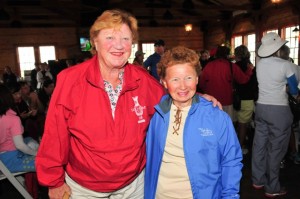The Illinois State Amateur was played for the 85th time in July, and this time it was more than a golf tournament. It was a showcase.
If nothing else, we should take away one thing from this State Am: the state of amateur golf in Illinois is at its highest level in many, many years. Frankly, I don’t think the caliber of play is quite at the level it was in the 1980s when the stars of the show were Gary Hallberg, Lance Ten Broeck, Gary Pinns, David Ogrin, Roy Biancalana and Jerry Haas – but it’s getting there.
Those guys went on to do a lot of good things at the next level (Hallberg, Ten Broeck and Ogrin even won on the PGA Tour) and I suspect members of the current cast of characters will do so as well.
Tee-K Kelly, for instance, has already done something that Ten Broeck, Pinns and Biancalana couldn’t do. He won the Illinois State Amateur a second time at Panther Creek in Springfield, his first win coming in 2013 at Aldeen in Rockford. Only 15 players have won the State Am multiple times, the most prominent being D.A. Points. Now a solid PGA Tour regular, Points ruled the state’s amateurs in 1995, 1998 and 1999.
Kelly was the first since Todd Mitchell’s completion of a back-to-back in 2003 to win a second title. It’ll be interesting to see where Kelly’s golf career goes from here. He played well in another big event this summer, finishing second to Bloomington’s Alex Burge in the Chicago District Amateur. Kelly has only the Western Amateur at Rich Harvest Farms left on his summer schedule, but a senior season at Ohio State awaits for the Medinah member.
I’m intrigued by more than Kelly, however. At the top of my list is Ray Knoll, soon to be a junior at Iowa. What’s with those Hawkeyes anyway? Knoll won the State Am last year, succeeding Iowa players Vince India and Brad Hopfinger as former champions. And Brian Bullington of Frankfort was the first-round leader this year after shooting a 66.
Knoll couldn’t defend his title, but showed his abounding promise in the final round when he let it all hang out and shot a course record 8-under-par 63. That is generally believed to be the lowest round shot in the State Am, records being sketchy from some past years.
Not only did he shoot that one low round, he also posted what’s believed to be the first albatross in the history of the tournament. The ability to pull off big shots is there, no doubt about it.
Knoll saw his title defense evaporate after shooting a 75 in the morning 18 holes of the 36-hole final day at Panther Creek. Making six birdies in the first 11 holes in the afternoon, all from the four to 10-foot range, Knoll climbed the leaderboard but saved his best for No. 15, a 576-yard par-5.
“Going to the last round I knew I didn’t have a chance to win, but I was playing good and just tried to be aggressive,’’ he said. So, at No. 15 he blasted a “perfect’’ drive, then studied the possibility of going for the green with his second.
“I didn’t know what my yardage was because my rangefinder died when I was on the 10th hole,’’ he said. “I stepped it off from the 200-yard marker and found the yardage was 267 yards plus three more to the pin. I hit a high draw with my 3-wood and swung a little harder because that distance was a little out of my range.’’
Well, actually it wasn’t. His ball landed on the front of the green, bounced once and rolled into the hole. It was his second albatross, the first coming on a 6-iron shot from 191 yards while playing an informal round with his father at Hickory Ridge in Carbondale. This one elevated Knoll to under-par status for the tournament and into a tie for sixth place. That’s got to get your attention.
Knoll’s hot round took the spotlight away from Northbrook’s Nick Hardy, who is coming off a terrific freshman year at Illinois and matched the Panther Creek record of 65 before Knoll topped him. Hardy also made the cut in the U.S. Open at Chambers Bay, so he’s going places, for sure. Watch for him in both the Western and U.S. Amateurs this month, to say nothing of future years.
And Hardy isn’t the only young phenom in the state ranks. The State Am was a coming out part of sorts for 18-year old Conor Dore. Rarely do Chicago city residents surface in big state-wide tournaments, but Dore did. He led the State Am by four strokes entering the final round and had a putt to win at Panther Creek on the last hole of regulation but left a 30-foot birdie try short. Then he lost the title in a playoff with Kelly.
The near-miss by Dore, just out of Whitney Young High School, was reminiscent of Quinlan Prchal’s showing just out of high school in the 2012 State Am. Prchal, from Glenview, won the title at Kokopelli, in Carbondale, before heading to his freshman year at Princeton. He tied for 16th at Panther Creek, by the way, so he’s still very much in the mix for future stardom.
Dore’s tournament schedule has been almost entirely in the junior ranks so far. That’s what college coaches had advised him to do. But he did step out once last year at age 17 and led a qualifying session for the Illinois Open. He missed the cut in the tournament proper, but his strong showing in the State Amateur – he led for most of the final round — was eye-opening.
I’d class Hardy and Dore, who is headed to Southern Illinois-Edwardsville, as the very young in this era of players with so much promise. A couple with a little more seasoning who are worth noting are Alex Burge, a redshirt senior in coach Mike Small’s powerhouse program at Illinois, and Bullington, a recent Iowa grad.
Hardy wound up third at Panther Creek while Burge was fourth and Bullington tied for sixth.


